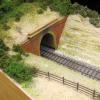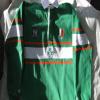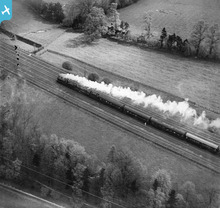EPW035172 ENGLAND (1931). A double-headed passenger train steaming north towards Watford, Carpenders Park, 1931
© Copyright OpenStreetMap contributors and licensed by the OpenStreetMap Foundation. 2025. Cartography is licensed as CC BY-SA.
Details
| Title | [EPW035172] A double-headed passenger train steaming north towards Watford, Carpenders Park, 1931 |
| Reference | EPW035172 |
| Date | May-1931 |
| Link | |
| Place name | CARPENDERS PARK |
| Parish | WATFORD RURAL |
| District | |
| Country | ENGLAND |
| Easting / Northing | 511785, 193607 |
| Longitude / Latitude | -0.38476888533137, 51.629688426205 |
| National Grid Reference | TQ118936 |
Pins

Leslie B |
Thursday 27th of January 2022 02:29:55 PM | |

John Wass |
Wednesday 13th of May 2015 03:35:13 PM | |

Maurice |
Sunday 9th of June 2013 06:46:12 AM | |

Maurice |
Sunday 9th of June 2013 06:28:32 AM | |
Sorry Maurice, but MB has it correct in that the leading engine is an ex-LNWR engine. There's evidence of a nameplate around the leading spasher too. It's clearly not a 'compound' as there are no outside cylinders, and they weren't named! |

Isleworth1961 |
Thursday 13th of June 2013 12:48:53 PM |

MB |
Saturday 15th of December 2012 10:22:41 AM | |
More likely a kitchen (front end) restaurant car. I think you can see the white tablecloths in the windows! The concept of a buffet car was not that well formed in the early 1930s "Hampers (with pre-packed picnics) were in a sense precursors of the modern buffet car, a vehicle which did not really achieve any great significance until the 1903s and which did not really come into its own until the modern day." Jenkinson, D. "The history of British Railway Carriages 1900-1953" p 205. |

Maurice |
Friday 7th of June 2013 08:13:25 AM |
In addition to my previous comments on the "buffet car" suggestion of MB's, the inscription on the side is not clear enough to read, but could well be Kitchen Car (but possible equally well be Buffet Car). However the double doors between the first and second windows from the front and the amount of ventilation on the roof suggests that some serious cooking was going on in this part of the train. |

Maurice |
Sunday 9th of June 2013 06:51:09 AM |

Chris Willis |
Friday 14th of December 2012 11:47:20 PM | |

Chris Willis |
Friday 14th of December 2012 11:46:34 PM | |

Chris Willis |
Friday 14th of December 2012 11:45:52 PM | |

Chris Willis |
Thursday 13th of December 2012 11:34:09 PM |
User Comment Contributions
The pilot locomotive may be a member of George Whale's 'Precursor' class, built at Crewe between 1904 and 1907. By the 1930s they were becoming obsolete with the introduction of Stanier's 'Black Fives' |

MB |
Sunday 9th of June 2013 06:53:17 AM |
It is more likely to be a LMS compound (see more detailed comment elsewhere). |

Maurice |
Sunday 9th of June 2013 06:53:17 AM |
I suppose it's a toss-up between this picture of the LMS double-headed train heading towards Watford in 1931 and the slightly earlier one of the Johnson 3P class near Burton-upon-Trent. However, I shall show my southern (Watford/Hertfordshire) bias and plump for the former image for inclusion in next year's publication! |

John Swain |
Thursday 16th of May 2013 03:23:57 PM |
You're local like me John? I'd go for this one too! Yours, Katy |
Katy Whitaker |
Thursday 16th of May 2013 03:23:57 PM |

John Swain |
Tuesday 14th of May 2013 10:26:22 AM | |
A view looking east-north-east towards the area south of Sherwoods Wood before the arrival of the mid-thirties suburban development of Carpenders Park. In the left foreground is the eastern extremity of the once-famous Oxhey Golf Course (1912-1952), prior to the building of Prestwick Road and the LCC estate at South Oxhey (1946-1952). The original railway lines were constructed in 1837 and the later additions came in 1913, when the Bakerloo Line was eventually extended from Willesden Junction to Watford Junction four years later. |

John Swain |
Tuesday 14th of May 2013 10:22:54 AM |
I'd hazard a guess and say somewhere south of Bushey on the main line out of Euston. The nearest pair of tracks are the Watford DC electrified lines and the LMS train seems to be on the down fast. |

BrianM |
Wednesday 2nd of January 2013 01:22:25 PM |
Thanks for all the suggestions everyone, I'm happy to accept this as TQ117937 area i.e. on the main line south of the Bushey/Oxhey water-troughs. The previous images taken by Aerofilms Ltd were over Watford and Bushey. We'll update the catalogue and post the new data here in due course. Yours, Katy Britain from Above Cataloguing Team Leader |
Katy Whitaker |
Wednesday 2nd of January 2013 01:22:25 PM |
To continue, is that the mile post near the end of the second carriage, in line with the second (closer) underpass? The signal post is a problem. (Map shows after second track). I think the visible post is the next telegraph pole. |

Chris Willis |
Friday 14th of December 2012 11:41:12 PM |
Possible position south of Watford heath. 1930s map shows six tracks. Also pedestrian underpass which seems to survive. http://www.old-maps.co.uk/maps.html?coords=511744,193850 1935 1:2500 map seems a pretty good fit |

Chris Willis |
Friday 14th of December 2012 11:12:25 PM |
The locomotives are clearly London Midland and Scottish Railway, the pilot engine appears to be a 4-4-0 with the train engine I think being a Royal Scot class 4-6-0. Judging by presence of main and relief lines and the LT electrified lines, somewhere on the main lines out of Euston to the north west of London? |

Toby Clempson |
Friday 14th of December 2012 01:38:24 PM |


![[EPW035172] A double-headed passenger train steaming north towards Watford, Carpenders Park, 1931](http://britainfromabove.org.uk/sites/all/libraries/aerofilms-images/public/100x100/EPW/035/EPW035172.jpg)
![[EAW022134] The South Oxhey Housing Estate under construction around Hayling Road, South Oxhey, from the east, 1949](http://britainfromabove.org.uk/sites/all/libraries/aerofilms-images/public/100x100/EAW/022/EAW022134.jpg)
